A little less than two weeks have passed since returning from Europe and I’m as lean as when I left, despite the more than ten pounds I gained—which, to be fair, was probably not all fat. In part one, I discussed eliminating breakfast, something I plan to continue through next Monday. This time, I want to explain back-loading carbs and calories.
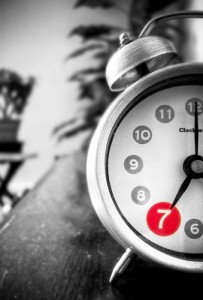 7 o’clock, better put down the fork.
7 o’clock, better put down the fork.For longer than I can remember, experts have bandied around a maxim, as if taken from some secret book of indisputable fat-burning facts, that if you want to lose weight, don’t eat past 7 in the evening. Hearing and reading this as often as I do, it doesn’t surprise me that repetition replaced truth. The explanation is convincing and when I was younger, I took for granted its validity because of the logic: metabolism drops, so feeding the body after 7pm sends calories straight to the gut (or waist, or thighs, or butt depending on who’s giving the advice and to what audience they give it). As naked logic is not always convincing enough, the experts also add that digesting all that food before bed destroys the quality of sleep.
This is a load of crap. The explanation sounds reasonable, and in the absence of controlled research, I’d say it’s a method worth following. But we do have controlled research and it makes anyone look ignorant who claims or suggests that eating after 7 increases fat gain—lipogenesis for you terminology geeks. The facts just don’t match this simplistic logic.
Believe me, I’m the last person to admit that reading the research articles is fun, and many people read the abstract—the summary at the beginning of the article—and make conclusions based on the synopsis. You’ve got to read the whole article and the eating-after-seven rule exemplifies why. Many of the abstracts for these studies say, “It seems advisable that for maximum weight loss, a larger proportion of calories should be eaten early in the day,” and while this is true, there’s more to the story.
In the weight-loss studies, participants either front-loaded calories (ate most of their food before 3 pm and only small amounts later) or back-loaded (ate most of their calories in the evening, up until going to bed). The front-loading groups lost 20% more weight. Hence the conclusion to not eat much in the afternoon and 7pm fits with most people’s schedules, so, why not?
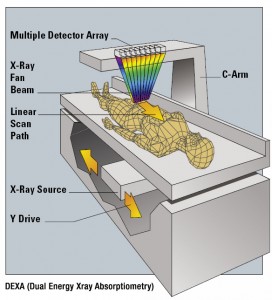 Diagram of a DEXA scanner.
Diagram of a DEXA scanner.Most nutrition writers know what sells and the number-on-the-scale is all important for marketing. I want results, not hype, and researchers want more information than comes from a digital bathroom scale. Besides examining body weight, researchers also perform DEXA measurements—dual-energy X-ray absorptiometry (DEXA) is a precise, accurate and non-invasive way to determine body composition. Body composition results tell a different story. The front loaders did lose 20% more weight, but the back-loaders lost 15% more fat. Starving the body through the night of calories ignites muscle wasting. If you eat in the morning, the body tries to maintain energy balance by keeping fat and burning muscle. If you eat at night, the body burns fat and preserves muscle. Back-loading calories—and definitely eating after 7pm—makes you leaner and healthier.
Keep in mind that this conversation relates to losing weight and maximizing fat loss, which was my entire goal over the last 14 days. I wanted to keep as much muscle as possible and get rid of the chub. If you’re eating enough to grow—grow either muscle mass or fat mass—it’s unknown if eating more at night as opposed to the morning will increase the rate at which you gain muscle. The studies to know don’t exist, but I have had experience with myself and others, and I can say, “it’s worth a try.”
I back-load calories by back-loading carbs, which is the third dietary component to my rapid fat loss plan. The simplest way to achieve carb back-loading would be to start the day sans carbs, adding say, 20 to 40 grams more than the last meal until reaching a crescendo at bedtime. This would be a linear increase or basic ramping up of carbs throughout the day. I prefer more of a switch. I hold off eating carbs until after I lift at about 3 in the afternoon, then my diet becomes high carb, whereas it started as ultra-low carb.
Taken without an understanding of how the body works this seems contrary to current wisdom, which is based in fact. Fact: the body is more sensitive to insulin in the morning. A logical corollary, often called wisdom: eat the majority of your carbs early in the day because the body uses more of the carbs and uses them faster. The fact is just that, so disputing it is not an option, but I have a problem with the corollary, however logical it may appear. To understand the breakdown in sensibility, we need to understand how cells use carbs.
 This is not what I mean by “backloading”
This is not what I mean by “backloading”Carbohydrate metabolism isn’t as simple or easy to understand as pop-media and even sports nutritionists imply. The classic version: carbs get into the bloodstream as sugar, which hits the pancreas and causes a release of insulin. Insulin rushes through the body and shuttles sugar into cells. This is the 300 ft view.
Looking closer, it’s not insulin that carries sugar into cells; specialized transporters exist within each cell that bring sugar across the cell membrane, transporters called, not surprisingly, glucose transporters (GLUTs). The class I GLUTs—GLUT1 through GLUT4—are the best understood. (There are two more classes that contain GLUTs 5-12, but—besides the fructose transporter, GLUT5—science is still deciphering their function, and some, like GLUT6 and GLUT8 actually block glucose transport.)
Different tissue contains different transporters. Tissue with GLUT1s, GLUT2s or GLUT3s use sugar whether insulin levels rise or not. Cells of the pancreas, kidney, small blood vessels and nervous system, including those in the brain, contain GLUTs 1 through 3. That doesn’t mean these cells need sugar, only that they can always use it regardless of the presence or absence of insulin.
GLUT4, however, sits tucked within the surface of the cell membrane until the cell senses insulin, at which point the GLUT4s move to the surface and start grabbing sugar and pulling it in. Fat cells and muscle cells contain GLUT4 receptors. When the experts say the body is most sensitive to insulin in the morning, they mean GLUT4 tissue—body fat and skeletal muscle.
The plus side to this information: fat cells can’t store as much sugar as fat in the evening. The minus side: muscles can’t use carbs effectively either. There is, anyhow, a way to keep the plus and eliminate the minus. It’s something everybody reading this blog already does: RT—resistance training. (And if not, why the hell are you here?)
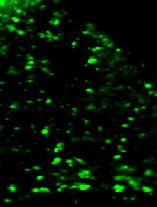 GLUT4 translocation in a fat cell
GLUT4 translocation in a fat cellRT does three things. 1) It increases the number of GLUT4 receptors per cell—muscles can then absorb and use sugar more rapidly. 2) RT makes muscles hyper-responsive to insulin—fat cells may not respond well in the evening to insulin, but muscles will. 3) RT moves GLUT4s to the cell surface without insulin—cells can now start soaking up sugar for quicker recovery after a workout, even in the evening. Effects (1) and (2) last about 48 hrs, and effect (3) is immediate and short-lived, perhaps a few hours at most.
Think about that for a minute. This is the stuff worth getting excited about. If you’re like me, you might be carb-sensitive, storing water and fat in your love handles and gut rapidly upon over eating for several days, particularly overeating carbs. By understanding a little more than the absolute basics, you can figure out when to time your carbs to increase muscle growth while making it difficult for fat cells to expand or multiply. How much easier could it get?
Okay, you got me: it’s not as easy as it sounds, but not much worse. You’re going the better part of the day without carbs, the exact thing the body needs for an intense, all-out battle with the iron. You, therefore, need to eat a massive amount of carbs in the evening. Whatever amount you would normally eat throughout the day, you’ve got to get it all in after your workout, starting with your post-workout shake (see the Protein 2.0 article).
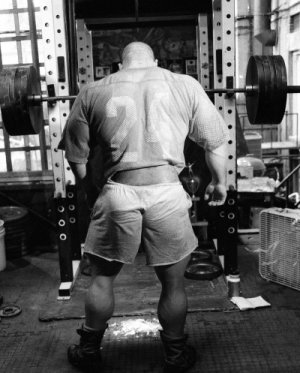 Squatting 5 plates per side for reps? Okay, drink some carbs.
Squatting 5 plates per side for reps? Okay, drink some carbs.Secondly, when that first shot of carbs hits your system, you run the risk of going hypoglycemic if you don’t get enough sugar. That could result in anything from breathing ammonia (going into ketosis, which is not a big deal), to the shakes and sweats. To mitigate this, I do 150 grams of the rilose powder (nearly pure glucose) in my post-workout shake. With this amount, I avoid any problems while weighing 230 lbs at 12 to 14% body fat. You can judge for yourself based on this. For example, if you’re 230 and 20% fat, you’d be fine with 75 to 100 grams of carbs post workout.
Let me address the major fear: lack of energy for workouts. I’ve never seen it happen or felt it happen. On most days, I feel stronger by not eating carbs until after I lift. Waiting to ingest carbs allows the body to recover fully and use the spare carbs to replenish glycogen reserves, which, when near-full, are more than enough fuel for the first half of the day and for a bone-grinding workout. If you’re worried, you can begin ingesting simple carbs about 15 minutes into your workout, but make sure they’re glucose based and not fructose, e.g. not soda or Gatorade, but rather maltodextrin or rilose—probably something you’ll need to mix yourself.
Here’s a sample day of food choice per meal when I’m slimming down.
Breakfast: Skip
Meal 1, 9am: Eggs, ham, cheese, tomatoes, protein shake
Meal 2, noon: beef, broccoli with butter, almonds, protein shake
Meal 3, 2pm: low-fat cottage cheese, almond butter, strawberries, protein shake, creatine
Meal 4, 4pm: Post workout shake containing roughly 60 grams of protein and 150 grams of carbs
Meal 5: 6pm: chicken, green beans, rice
Meal 6: 9pm: shit load of non-wheat, low-fat carbs (sweet rice cakes, my personal recipe for non-fat mashed potatoes), protein shake


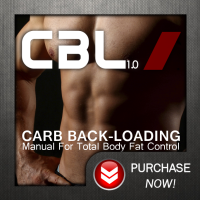





Recent Comments